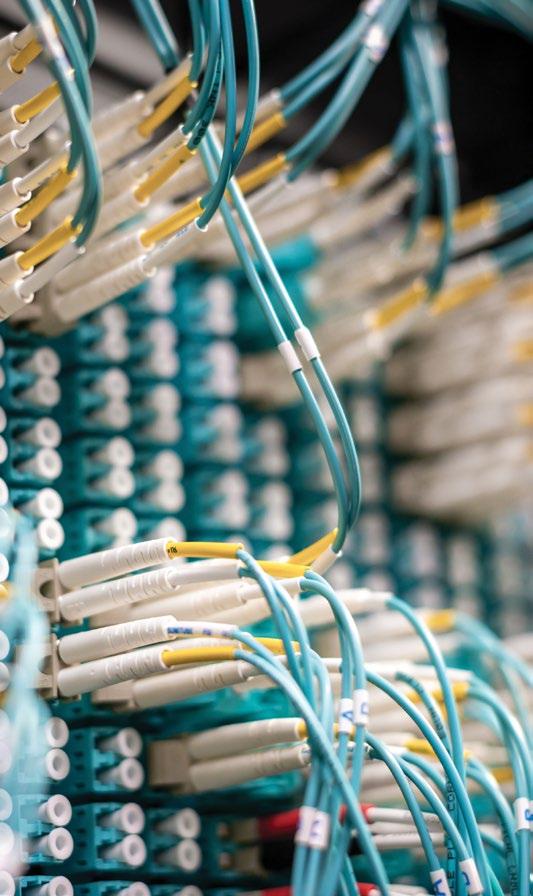
5 minute read
Have You Had Your Fiber Today?
By Daniel P. Rhodes, Managing Partner, CT Solutions
It is hard to believe the first interstate copper telephone cable was set up 137 years ago in 1885. The technology relies on a small amount of electric current to carry the voice from one end of the cable to the other. One copper wire is supplied to send a signal while the other is allocated to receive. This technology has since advanced to include the ability to send digital signals in addition to voice. Like the railroads, copper wire communication networks have been deployed from coast to coast. They have played a large part in the economic and social growth of every country on the globe.
Advertisement

American Telephone and Telegraph (AT&T) maintained a monopoly of the US communications network until 1984 when the US government forced a breakup and provided an open door for competition. The country was broken up into seven regions. Each region was assigned a Baby Bell or Regional Bell Operating Company (RBOC) to sell local dial-tone service and maintain the copper network infrastructure. AT&T continued to sell long distance service between the regions and overseas. The breakup also created the opportunity for additional private competition within these regions, and the Competitive Local Exchange Carrier (CLEC) was born. The number of smaller private providers grew throughout the 1990s, increasing the competition and pushing the development of technology-related business applications. In the late 1980s and early 1990s, the Worldwide Web—otherwise known as the internet— began to gain popularity. Individuals and corporations could now send messages and limited size documents within minutes versus receiving the same message days later via the US Postal Service. Businesses were able to post full-color advertisements, providing potential customers with much greater amounts of information than the expensive yellow page advertisements on which they had previously relied. Multiplayer video games no longer required traveling to a local arcade. The information age had begun, and the demand for data continues to increase even today.
Due to the increased demand, many copper networks frequently reached high-level stress points. It was becoming clear the networks would require expensive renovations or complete rebuilds. Carriers and technology industry manufacturers agreed that the deployment of fiber optic cable with capacities 1000-plus-times greater than that of its copper predecessor was the best solution. The installation of fiber optic cable accelerated in the late 1990s and has continued. What began as carrier-to-carrier backbone infrastructure has been extended directly to thousands of multi-tenant commercial buildings, many rural American towns, and even into private family homes. Due to the great expense of supporting multiple networks and technologies, several of the RBOCs have petitioned the FCC to release them from the liability of maintaining the older copper or Time Division Multiplexing (TDM) networks. The FCC has already approved some requests to pave the way for the newer, faster fiber optic technology. A large number of technicians familiar with the maintenance of the analog (TDM) networks have reached or will soon reach retirement and any continued training is not cost effective. The retirement of the analog copper networks is currently underway. Only a couple of weeks ago, a bipartisan infrastructure bill was passed through congress providing an estimated 65 billion in federal funding to expand fiber optic broadband access and 5G wireless connectivity into more rural communities. The shift from copper and
Continued on Page 52
analog to fiber optic and IP has a much greater reach than just the national communications infrastructure. In March of 2017, Toshiba, which had been manufacturing premise-based business telephone systems for over fifty years, sold the assets to Mitel and dropped out of the market. In December of 2019, Panasonic made a similar announcement to their distribution channels; they will discontinue manufacturing business phone systems in 2022. The reasoning behind these decisions can be tracked to the enormous gap between the limited capabilities of an analog system and the lightning-fast abilities of fiber optic. The additional network capacity and speed of fiber optic cable opened the door for continued development of business applications. Many of these new capabilities were put on display during the past eighteen months as businesses reconfigured their communications systems from the business park to the cell phones and lap-top computer screens of staff sitting in their living rooms or back-office bedrooms. Restaurants can manage the temperature of their walk-in coolers from an application on their cell phone. Business owners can monitor the foot traffic in their gas station or retail store through a live video feed anywhere in the world that provides internet access. Along with the benefits of fiber optic comes the challenges of retiring the reliability of the analog networks. The largest benefit of the copper analog networks is the low voltage current pushed through the transmission by the carrier. Many times, this provides the ability to communicate even through disastrous events. It was this ability that created the mandate by national fire department regulatory agencies and alarm monitoring centers requiring analog telephone lines for fire alarm panels, elevators, and burglar alarms systems. Many carriers can and will provide what is known as analog emulation to keep these emergency monitoring systems active, but the low voltage current during a power failure is not included.
Daniel Rhodes is the owner of CT Solutions. CT Solutions focuses on providing holistic technology solutions for businesses. Daniel has been in the business technology industry for over thirty years and has worked with both small local companies as well as multi-location global enterprises. For more information, visit http:// www.C-TSolutions.com, email drhodes@c-tsolutions.com, or call (435) 359-1057. Businesses are now converting the traditional emergency analog lines to 4G/5G wireless or an ethernet connection to the network to be transmitted via IP to the monitoring centers. Providing some type of a power failover system is recommended if not already required by the emergency response agencies. These emulation methods will work for currently installed premise-based phone systems as well. The key is to investigate your options and determine if throwing hard-earned revenues towards technology that is actively being decommissioned is the best decision for your business long-term. Understanding where the technology industry is going and why it is going there can be a monumental task, but it may prove vital to the success of your business.

Technology in Business Section Sponsored By












